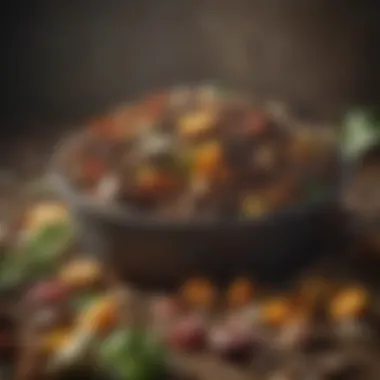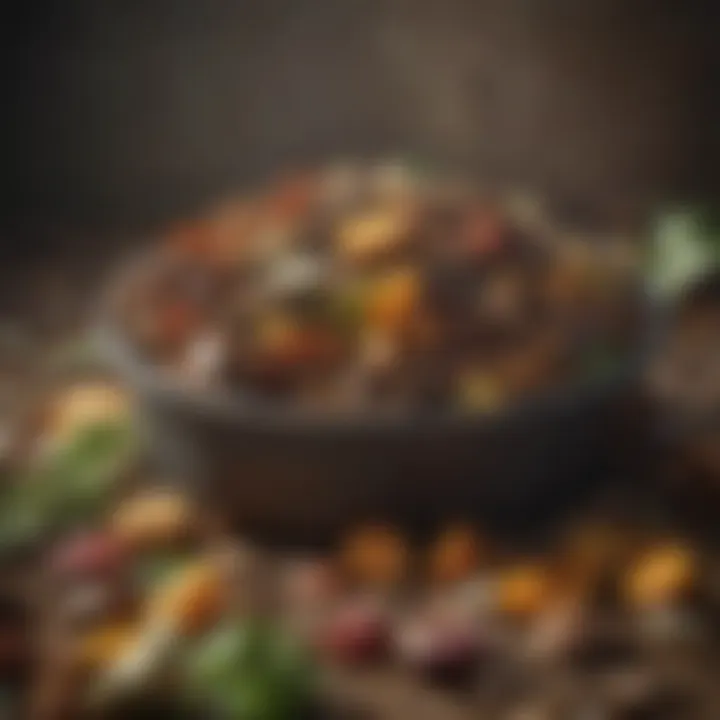Mastering the Art of Composting Kitchen Waste: A Comprehensive Guide


Overview of the Topic
When delving into the realm of composting kitchen waste, it is imperative to understand the fundamental principles underlying this eco-friendly practice. Composting serves as a natural process that transforms organic waste materials into nutrient-rich soil additives. By composting kitchen waste such as fruit and vegetable scraps, coffee grounds, and eggshells, individuals can contribute to reducing waste sent to landfills and promoting a sustainable environment.
Current Status and Challenges
Currently, the disposal of kitchen waste poses a significant environmental challenge globally. Organic waste sent to landfills contributes to greenhouse gas emissions and leachates that can contaminate soil and water sources. Inadequate waste management systems and limited awareness about composting further exacerbate the issue. Challenges include improper waste segregation, lack of composting facilities, and misconceptions about the composting process.
Sustainable Solutions
In response to the pressing need for effective waste management, various sustainable solutions have emerged to promote kitchen waste composting. Initiatives focusing on community composting, home composting bins, and educational programs have been instrumental in encouraging individuals to compost their organic waste. By adopting composting as a sustainable practice, communities can reduce landfill waste, enrich soil health, and minimize environmental pollution.
Impact and Importance
The impact of composting kitchen waste extends beyond individual actions, fostering broader benefits for ecosystems and communities worldwide. Composting helps conserve natural resources, improve soil fertility, and reduce the carbon footprint associated with waste decomposition. Moreover, the importance of composting lies in its ability to exemplify sustainable living practices, promote environmental stewardship, and pave the way for a greener future for generations to come.
Introduction
Composting kitchen waste is a crucial practice for individuals looking to reduce their environmental footprint and contribute to a healthier planet. By understanding the nuances of composting, individuals can harness the power of natural decomposition to create nutrient-rich soil amendments that promote plant growth and reduce the burden on landfills. This section will delve into the intricate world of composting kitchen waste, exploring the different materials that can be composted effectively and the impact of this eco-friendly practice on sustainability.
Understanding Composting
In understanding composting, one must grasp the fundamental process of organic decomposition and its role in nutrient recycling. Composting is not merely a way to dispose of kitchen waste but a sustainable method to harness natural decomposition for soil enrichment. By breaking down organic matter into humus, composting facilitates nutrient circulation in the ecosystem, creating a closed-loop system of resource utilization. Understanding the science behind composting is essential for optimizing the process and maximizing its benefits.
Importance of Composting Kitchen Waste
The importance of composting kitchen waste cannot be overstated in the realm of environmental conservation. By diverting organic matter from landfills, where it emits potent greenhouse gases, composting significantly reduces methane emissions and mitigates the harmful effects of waste disposal on climate change. Moreover, composting nurtures soil health by enhancing its structure, increasing water retention, and promoting the growth of beneficial microorganisms. This section will illuminate the profound impact of composting kitchen waste on waste reduction, soil fertility, and sustainable agriculture.
Overview of the Article
This article serves as a comprehensive guide to composting kitchen waste, delineating the types of materials that can be composted effectively and those that should be avoided. From fruit and vegetable scraps to coffee grounds and eggshells, each category of kitchen waste will be analyzed in detail to guide readers in their composting journey. Additionally, essential tips for effective composting, such as balancing green and brown materials, maintaining moisture levels, and monitoring the composting process, will be outlined to empower individuals to embark on a sustainable waste management practice. This overview sets the stage for a detailed exploration of composting techniques and their positive implications for environmental stewardship.
Compostable Kitchen Waste
Compostable kitchen waste plays a vital role in the journey towards sustainable living. Understanding the significance of composting kitchen waste is crucial for individuals looking to minimize their environmental impact and contribute to a greener planet. By composting organic materials like fruit and vegetable scraps, coffee grounds, eggshells, tea bags, nut shells, grains, pasta, bread, baked goods, herbs, spices, paper towels, napkins, cardboard, houseplant trimmings, and wooden items, one can reduce the amount of waste sent to landfills while creating nutrient-rich soil amendments for gardening. Embracing composting can lead to a more sustainable lifestyle, decrease methane emissions from landfills, and promote the circular economy.


Fruit and Vegetable Scraps
Fruit and vegetable scraps are excellent candidates for composting due to their high nutrient content. When these scraps break down in a compost pile, they release essential nutrients that enrich the soil, supporting healthy plant growth. Remember to chop larger scraps into smaller pieces to facilitate quicker decomposition. Avoid composting diseased or pest-infested plant material to prevent the spread of pathogens in your compost pile.
Coffee Grounds and Filters
Used coffee grounds and filters are valuable additions to a compost heap. Coffee grounds contain nitrogen, which is a key component for successful composting. Ensure that the coffee grounds are spread out within the compost pile to prevent clumping and improve aeration. Incorporate coffee filters made from unbleached paper into the compost as they will decompose along with the grounds.
Eggshells
Eggshells are rich in calcium, an essential nutrient for many plants. Crush the eggshells before adding them to the compost to accelerate the decomposition process. The calcium from the eggshells will help neutralize acidic conditions in the compost pile, balancing the pH levels for optimal microbial activity.
Tea Bags
Tea bags, especially those made from natural fibers, are compostable. However, remove any staples or synthetic elements before including them in the compost. Used tea leaves and bags provide organic matter that enhances the compost's texture and moisture retention capabilities.
Nut Shells
Nut shells are valuable additions to compost as they contribute carbon, an important element for the carbon-to-nitrogen balance in the pile. Crush larger nut shells to expedite their breakdown. Walnut shells, almond shells, and pistachio shells are all suitable for composting.
Grains and Pasta
Leftover grains and pasta can be composted effectively, adding bulk to the compost and increasing its organic matter content. Cooked grains and pasta are acceptable for composting as long as they are not mixed with sauce, oils, or seasonings that may attract pests. These food items decompose readily in a compost pile.
Breads and Baked Goods
Stale bread, leftover baked goods, and expired pastries can all be composted. Break them into smaller pieces to speed up decomposition and prevent clumping. These items provide a good source of carbon for the compost, balancing the carbon-to-nitrogen ratio.
Herbs and Spices
Herbs and spices past their prime or those you no longer need can be composted. Incorporating these aromatic elements into the compost pile adds diversity to the composting process. Herbs and spices contribute organic matter and help create a well-rounded compost mixture.
Paper Towels and Napkins
Used paper towels and napkins made from unbleached or recycled paper are suitable for composting. Tear them into smaller pieces to accelerate breakdown. These items add absorbency to the compost and assist in maintaining moisture levels.
Cardboard


Cardboard, especially corrugated cardboard, is an excellent source of carbon for the compost pile. Shred or tear the cardboard into manageable pieces to encourage faster decomposition. Avoid glossy or coated cardboard as they may contain chemicals harmful to the composting process.
Houseplants Trimmings
Trimmed leaves, stems, or flowers from houseplants can be composted. These organic materials enrich the compost with moisture and minerals. Avoid including any diseased plant material to prevent the introduction of pathogens into the compost heap.
Wooden Items
Small wooden items like toothpicks, skewers, and chopsticks can be composted. Ensure that these items are untreated or finished with eco-friendly materials to prevent any harmful substances from leaching into the compost. Wooden items provide a source of carbon for the compost pile, aiding in the decomposition process.
Non-Compostable Kitchen Waste
In the realm of composting kitchen waste, understanding the distinction between compostable and non-compostable items is paramount. While the focus is often on what can successfully decompose to enrich the soil, recognizing non-compostable waste is equally vital. Non-compostable kitchen waste refers to items that should not be added to the compost pile due to various reasons such as potential contamination, slow decomposition, or attracting pests. This section sheds light on the significance of addressing non-compostable kitchen waste within the broader context of sustainable waste management and ecosystem preservation.
Meat and Dairy Products
When it comes to non-compostable kitchen waste, meat and dairy products stand out as prime examples. These items are rich in proteins and fats, which may not break down efficiently in a typical composting environment. Moreover, their decomposition can lead to unpleasant odors and can invite unwanted pests such as rodents and flies. Thus, it is advisable to refrain from composting meat and dairy products to maintain a healthy and odor-free compost pile. Instead, consider alternative disposal methods such as proper recycling or disposal in designated waste bins to prevent contamination and maintain compost quality.
Oils and Fats
Oils and fats constitute another category of non-compostable kitchen waste that pose challenges in composting. These substances do not integrate well with the composting process and can create a compact, anaerobic environment within the pile. Accumulation of oils and fats in the compost can hinder airflow, impede microbial activity, and result in a malodorous composting system. To avoid such issues, it is advisable to collect used cooking oils and fats separately for recycling or disposal through specialized facilities that can handle such waste effectively.
Bones
Including bones in a compost pile falls under the non-compostable category due to their slow decomposition rate and potential attraction of pests. Bones are dense and rich in minerals, making them resistant to breakdown in a home composting setup. Moreover, the presence of bones can disrupt the balance of the compost heap, impeding optimal decomposition of organic matter. To manage bones responsibly, consider disposal methods such as curbside collection services, local composting facilities, or specialized waste disposal units to ensure proper handling and prevent compost contamination.
Citrus Peels
While fruit and vegetable scraps are generally considered compostable, citrus peels present a unique challenge in composting due to their acidic nature. Citrus peels contain essential oils and compounds that can inhibit the growth of beneficial microbes essential for the composting process. As a result, adding citrus peels to a compost pile may disrupt the microbial ecosystem and slow down decomposition. To address this issue, consider alternative uses for citrus peels such as organic cleaners or flavorings, or explore separate disposal options to maintain the efficiency and quality of the composting process.
Diseased Plants
Diseased plants, including those affected by fungal, bacterial, or viral infections, are classified as non-compostable kitchen waste to prevent the spread of diseases and pathogens in the compost pile. Introducing diseased plants to the compost can potentially contaminate the entire pile and jeopardize the health of future plants where the compost is applied. It is essential to segregate and dispose of diseased plants through proper waste management channels to mitigate the risk of disease transmission and safeguard the integrity of the composting ecosystem.
Pet Waste
Pet waste, such as litter or droppings, falls into the category of non-compostable kitchen waste due to the presence of pathogens and parasites that can pose health risks to humans and contaminate the composting process. Discarding pet waste in the compost pile can introduce harmful pathogens into the environment, compromising the safety and quality of the compost. To handle pet waste responsibly, utilize specialized pet waste disposal systems, designated waste bins, or seek professional waste management services to ensure proper sanitation and prevent any adverse impacts on the composting process.


Coal Ash
Coal ash, a byproduct of burning coal, is considered non-compostable kitchen waste due to its high toxicity levels and potential environmental hazards. Coal ash contains heavy metals and chemicals that can leach into the soil, posing risks to plant growth and microbial activity in the compost pile. Directly incorporating coal ash into compost can contaminate the entire batch and render it unsuitable for agricultural or landscaping use. To manage coal ash safely, adhere to local regulations for disposal or seek specialized facilities equipped to handle hazardous waste materials effectively.
Plastic and Glass
Plastic and glass items are unequivocally non-compostable kitchen waste that should never be introduced into a composting system. These materials are non-biodegradable and can persist in the environment for extended periods, causing pollution and harm to wildlife. Introducing plastic and glass into the compost pile not only disrupts the natural decomposition process but also leads to contamination of the compost with non-organic substances. Proper disposal of plastic and glass materials through recycling programs or designated waste collection services is crucial to prevent environmental damage and maintain the purity of the composting cycle.
Tips for Effective Composting
Effective composting is a critical aspect of waste management, especially when dealing with kitchen scraps. This section delves deep into the pivotal role of efficient composting techniques in reducing waste and enriching the environment. By following these tips, individuals can ensure their compost pile transforms into nutrient-rich soil amendment. Achieving a balance between green and brown materials is essential for successful composting. Green materials, like kitchen scraps and grass clippings, provide essential nitrogen, while brown materials such as leaves and straw offer carbon. Mixing these materials in the right ratio accelerates decomposition and enriches the compost with the necessary nutrients.
Balancing Green and Brown Materials
Balancing green and brown materials in composting is crucial for the breakdown process. Too much green results in a smelly, slow decomposition, while excessive brown leads to a lack of nutrients. Composters need to maintain a ratio of roughly 2 parts brown to 1 part green to optimize the composting environment. This balance ensures aeration, proper moisture levels, and an ideal habitat for microorganisms to thrive, breaking down organic matter efficiently and effectively.
Maintaining Moisture Levels
Another key factor in composting effectively is monitoring and maintaining proper moisture levels. The compost pile should resemble a damp sponge - not too wet to become waterlogged, nor too dry to impede decomposition. Regularly checking the moisture content and adding water or dry materials as needed helps create an optimal environment for microbial activity. Adequate moisture ensures that beneficial microorganisms can thrive, speeding up the decomposition process and producing quality compost.
Turning the Compost Heap
Turning the compost heap is a vital step in the composting process. This action aerates the pile, redistributes moisture and accelerates decomposition by exposing new organic materials to microorganisms. Turning the heap every few weeks ensures even decomposition and prevents the formation of unpleasant odors. It also helps in breaking down large pieces of organic matter into smaller particles, promoting faster breakdown and producing compost efficiently.
Monitoring the Composting Process
Regular monitoring of the composting process is necessary to gauge the pile's progress. Observing temperature, texture, and odors can provide valuable insights into the decomposition rate. Adjustments to the compost pile, such as adding more brown materials for balance or watering to maintain moisture levels, can be made based on these observations. Monitoring enables composters to troubleshoot any issues early on, ensuring a successful composting journey.
Avoiding Composting Pitfalls
While composting offers numerous benefits, there are common pitfalls to avoid. These include adding non-compostable items, such as meat and dairy products, which can attract pests and cause odors. It is also essential to avoid creating compacted layers in the pile, as this restricts airflow and slows down decomposition. By being mindful of what goes into the compost pile and maintaining proper aeration and moisture levels, individuals can steer clear of potential pitfalls and create high-quality compost for their garden or landscape.
Conclusion
In delving into the intricate realm of composting, we unravel an essential practice pivotal for sustainable living. The Conclusion segment heralds a profound commitment to environmental stewardship through the conscientious conversion of kitchen waste into invaluable compost. By encapsulating the philosophy of waste reduction and ecological nurturing, this conclusive passage accentuates the crux of our discourse, imploring individuals to embrace the transformative power of composting. It underscores the symbiotic relationship between human actions and environmental consequences, shedding light on the significance of sustainable practices.
Embracing Sustainable Practices
Within the tapestry of sustainable living, composting emerges as a beacon of eco-consciousness. Embracing Sustainable Practices entails a holistic approach towards waste management, advocating for the harmonious integration of organic matter back into the earth. Through meticulous sorting of compostable materials and dedicated compost maintenance, individuals partake in a cyclical process of regeneration and resource maximization. This section advocates for mindful consumer habits and proactive engagement with the natural world, fostering a culture of sustainability and environmental responsibility.
Impact of Composting on the Environment
The Impact of Composting on the Environment transcends mere waste management, delineating a profound narrative of ecosystem preservation and biodiversity conservation. Composting acts as a catalyst for soil enrichment, fostering microbial diversity and vitality essential for plant growth and ecological balance. By diverting organic waste from landfills and incineration facilities, composting mitigates greenhouse gas emissions and reduces the carbon footprint of human activities. This segment expounds on the cascading benefits of composting, illustrating its transformative potential in shaping a greener, healthier planet for current and future generations.



